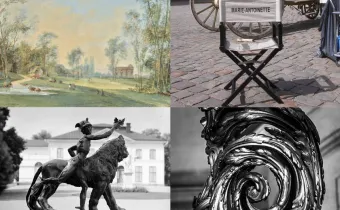An antechamber at the heart of the palace court system
Located in the main part of the palace, in the heart of the royal residence, the Œil-de-Bœuf antechamber is one of the last architectural achievements of King Louis XIV at Versailles. The antechamber was created by uniting two separate rooms: the Salon des Bassans – named for the Venetian painter Jacopo Bassano whose work adorned the walls – and the king’s former bedchamber.
In 1701, Louis XIV ordered a part of his State Apartment to be refurbished. His bedchamber was transferred to the adjacent Salon d’Axe, the King’s current Bedchamber. The partition separating the Salon des Bassans and the former chamber was torn down, creating an expansive new room designed with an Œil-de-bœuf window, whence its name. Jules Hardouin-Mansart oversaw the work, assisted by Robert de Cotte.
The new antechamber borders the Hall of Mirrors, the King’s new bedchamber and the Queen’s private chambers. Thanks to this central position, the room played an essential role in the workings of the Court.
It served as a waiting room for courtiers granted the privilege of attending the King’s daily petit lever and grand lever. They would enter the sovereign’s bedchamber according to a codified ritual known as the entrée. Six entrées were practised each day, each reserved for members of the King’s retinue based on rank or regal function. For example, upon the first “intimate” entrées, the chief physician, the chief surgeon and the royal children were admitted, while courtiers designated at the King’s discretion could enter the bedchamber as part of the fifth entrée.
A decor ahead of its time
Jules Hardouin-Mansart designed the Œil-de-Bœuf antechamber with a precious decor commensurate with its curial function and its proximity to the King’s bedchamber. Applying certain stylistic codes associated with French royalty, such as white and gold panelling, the architect blended tradition and a modern spirit. While the Louis XIV style was known for sumptuous and heraldic designs, the 1701 Œil-de-Bœuf antechamber is a piece marking the beginning of the rococo style, which flourished some 30 years later under Louis XV.
As such, unlike the Hall of Mirrors and the king’s State Apartment, no martial allegories or depictions of the gods of Antiquity adorn this chamber. The decorative features are decidedly lighter, illustrating a shift away from the strict and rigorous artistic tastes of the 1680s: the panelling is embellished with flowery garlands, shells and frolicking children. The Œil-de-Bœuf antechamber is the last remaining specimen of this transition between the style of Louis XIV and that of Louis XV at Versailles.
The restoration
The Œil-de-Bœuf antechamber maintained its precious decor under the Ancien Régime and suffered relatively little from the vandalism during the Revolution and the remodelling initiatives carried out under Louis-Philippe. A few modest restoration initiatives were implemented in the 1920s and 1930s, with the first large-scale renovation of the chamber executed in the 1980s.
Today, the room is in a state of disrepair, and the room’s architectural and decorative features are threatened: cracks have appeared all over the surface of the voussoir, the panelling is warped and suffers from structural flaws, while the gilding, pristine in some places, is heavily damaged in others. The paintings adorning the chamber, installed flush with the walls under the Bourbon Restoration – including Jean Nocret’s exceptional Famille royale dansl’Olympe (The Royal Family in Olympus) – have already been removed and are currently being restored. The project, set to begin in February 2023, involves a comprehensive restoration of the antechamber, including removal and refitting of the woodwork, refurbishment of joinery and reconditioning of metal features.
The first phase of the project includes all essential restorations and covers all the main features of the antechamber. A second phase will focus on refurbishing the overdoors, sculptures, and painting-gilding embellishments.
A restoration initiative in line with the “Grand Versailles” master plan
In 2003, the French Ministry of Culture and the Public Establishment of the Palace, Museum and National Estate of Versailles initiated the implementation of the ambitious “Grand Versailles” project, structured around three main objectives: restoring the historical monument and its decorations, securing the site as a whole, and better meeting the needs of visitors.
As such, alongside architectural work to restore the decor of the Œil-de-Bœuf antechamber, safety features will also be reinforced to better preserve the artwork and enhance the fire detection system. The lighting and air handling systems will also be overhauled.





